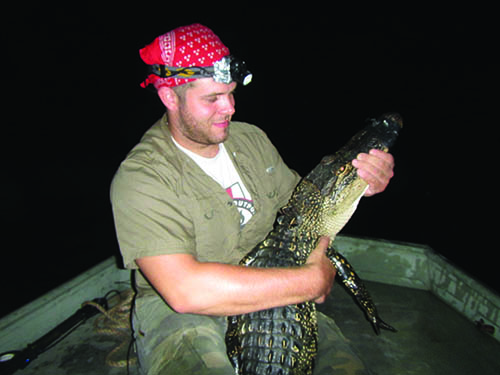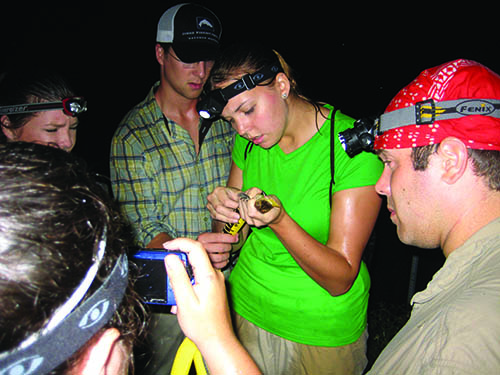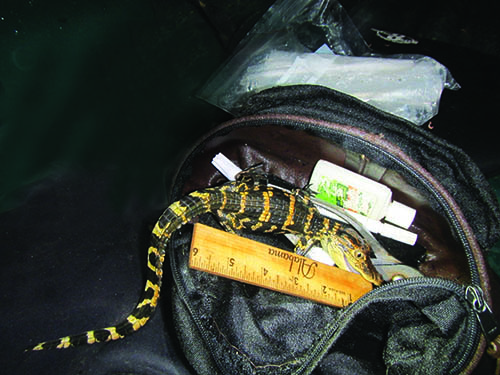Biological Sciences
Jack Feminella, Department Chair
Alligator Hunters on the Prowl

The adventure typically begins shortly before sundown as three researchers from COSAM’s Department of Biological Sciences step aboard a 16-foot Jon boat, permits in hand, to search for and capture alligators in the Eufaula National Wildlife Refuge. They locate the reptiles by eye shine and stealthily float toward them. If they are successful in getting near an alligator in the water without disturbing it, they quickly slip a noose around its neck.The alligator will then react viciously and mount a valiant struggle to escape.
Chris Murray, a doctoral student in the Department of Biological Sciences, is the reason the scientists are exploring the grounds of the refuge as his research pertains to crocodilians and is directed by renowned herpetologist and biological sciences professor Craig Guyer. Murray, along with Shawn Jacobsen, field lab coordinator, and Matt Kearley, non-major general biology coordinator, both of the Department of Biological Sciences, caught more than 60 alligators in 2012 in the Eufaula National Wildlife Refuge, and most were caught by hand. The biologists said they are drawn to the thrill of learning about the natural world, and alligators present a unique challenge.
“Alligators are very powerful, so we like to have at least three people in the field to increase safety and manpower because their behavior can be unpredictable,” explained Jacobsen.
If the gator is small enough, the scientists will pull it aboard the boat. Otherwise, they will haul the alligator to shore. The team also captures alligators on land, often by hand. However, any animal measuring five feet or larger must be caught using a noose. Once an alligator is tired and within reach, Murray will set himself on top of the animal and hold its mouth closed as someone else tapes the mouth shut. At this point, data is collected.
“Chris has the most experience with gators, by far. He can do things with alligators that are just phenomenal. I have been around animals my whole life, and he is just phenomenal,” said Kearley. “We caught one that was about six-feet long. We had it up on shore and I was holding it with a rope around its neck. Chris would touch its tail to see how fast it was reacting. Once he determined that it was tired enough, he jumped on it. He has a good gauge on when you can and can’t do things with a gator.”
Murray first gained experience working with alligators during high school while he was living in Connecticut. As part of a high school project, he and a neighbor, Jon Lord, traveled to the Everglades to create a documentary style film about reptiles and amphibians.
 Noting his enthusiasm, Murray’s mother contacted the Everglades Alligator Farm and arranged for her son to work at the park during the summer when he was 16. Murray continued to work at the park, honing his alligator-handling skills, every summer until he finished his undergraduate degree. His talent and wisdom serve as a guide for the scientists during their research efforts in the refuge, and he has even been featured on Animal Planet’s television show, Gator Boys.
Noting his enthusiasm, Murray’s mother contacted the Everglades Alligator Farm and arranged for her son to work at the park during the summer when he was 16. Murray continued to work at the park, honing his alligator-handling skills, every summer until he finished his undergraduate degree. His talent and wisdom serve as a guide for the scientists during their research efforts in the refuge, and he has even been featured on Animal Planet’s television show, Gator Boys.
“The Crocodile Hunter really sparked my enthusiasm for the field, and then later, it was the real-life, in-your-face-experience of working with the animals that made me realize I really love it. They opened my eyes and showed me how to handle the animals safely. I can’t imagine doing anything else,” said Murray.
For his dissertation, Murray is looking at the effects of land use, climate change, and aquatic chemical additives on the sex ratios of crocodile populations in Costa Rica. He explained that some of the hypotheses he will test in Costa Rica can be looked at in Eufaula, like the microhabitat of a nest, which is a term to describe where a nest is located and how the location affects the thermal regime of the nest eggs and thus the sex of the hatchlings.
The team also collects a blood sample from some of the captured alligators, which provides information on concentrations of stress and reproductive hormones.
“I am evaluating whether there is a difference between sexually active and non-sexually active alligators, young versus old alligators, and whether there are any seasonal differences,” said Murray.
After the team captures an alligator and secures it, they also check to see whether it is a male or a female, and they mark the animal by clipping its scutes. The scutes are clipped so that the following year, as research efforts continue, they will recognize any alligators that were previously caught. Marking the alligator also
allows them to gauge the population size and measure any changes that have taken place in terms of the alligator’s length and the location where it is found.
Other research efforts surrounding the alligators at Eufaula National Wildlife Refuge take place during the day and involve nesting habits. The team wades through waist-high vegetation looking for alligator nests, which are typically found in open areas in the sun. Some of the alligators in Eufaula, however, appear to prefer forested areas in the shade. According to the research team, the alligator population in Eufaula has other unique traits as well: some of them build their nests using mud instead of straw; the mothers are rarely found tending their nests; and the population, in general, tends to be more skittish than populations found in other areas.
Undergraduate student Colt Sanspree, a senior in the College of Forestry and Wildlife Sciences, is also working on a research project in connection with the work of the COSAM alligator researchers.
 “Colt is looking at sexual dimorphism in head shape between male and female alligators and young and old alligators,” explained Murray.“He is also conducting a study on what the alligators are eating. They are eating a lot of nutria in Louisiana and a lot of crab in south Florida, but we are not sure what they are eating this far north to attain their size.”
“Colt is looking at sexual dimorphism in head shape between male and female alligators and young and old alligators,” explained Murray.“He is also conducting a study on what the alligators are eating. They are eating a lot of nutria in Louisiana and a lot of crab in south Florida, but we are not sure what they are eating this far north to attain their size.”
All of the data collected by the researchers is shared with the Eufaula National Wildlife Refuge, the U.S. Fish and Wildlife Service, and the State of Alabama so that the agencies can work together to make informed management decisions on the conservation, harvest and/or protection of the alligator population in Eufaula.
“Working with the alligators is a challenge and a thrill, which is probably a lot of what draws us to the research,” said Jacobsen of the team. “We all three have a certain personality type that loves to seek answers to questions, and we are drawn to the appeal of hypothesis testing. Most of all, we are drawn to the adventure of working with these wonderful, fascinating predators that have been around for millions of years.”
- Photos courtesy of Matt Kearley.
